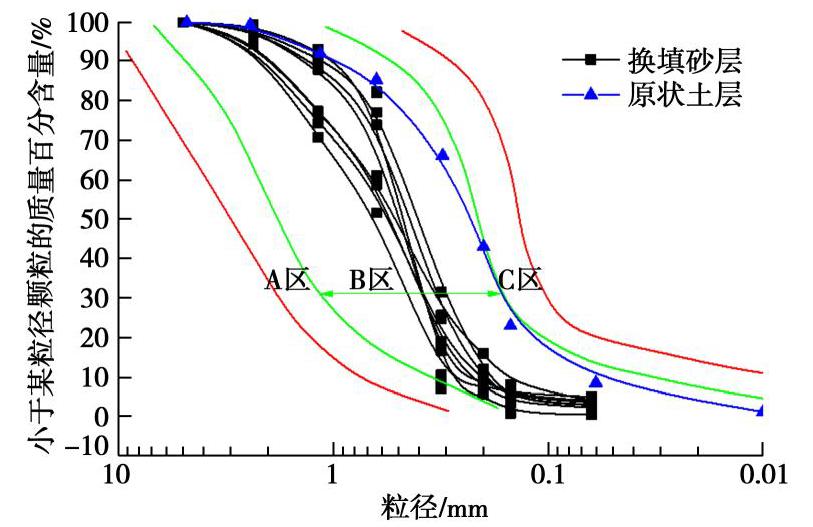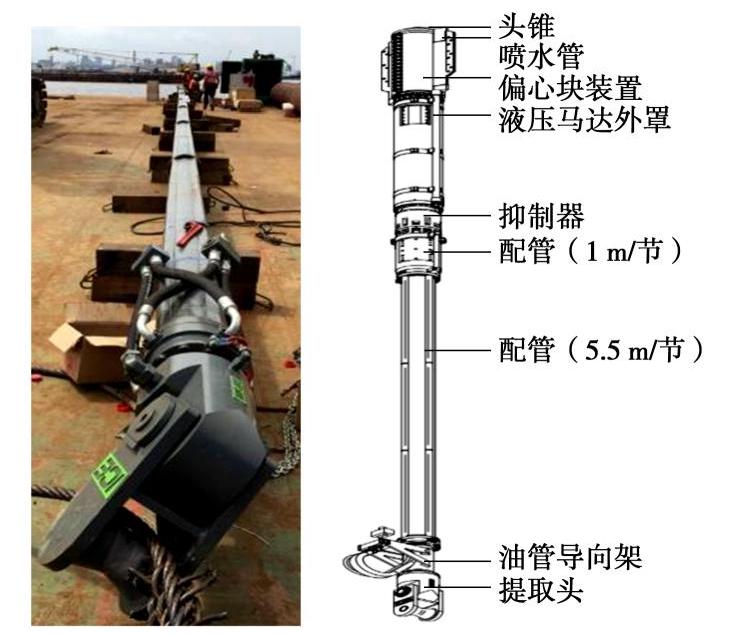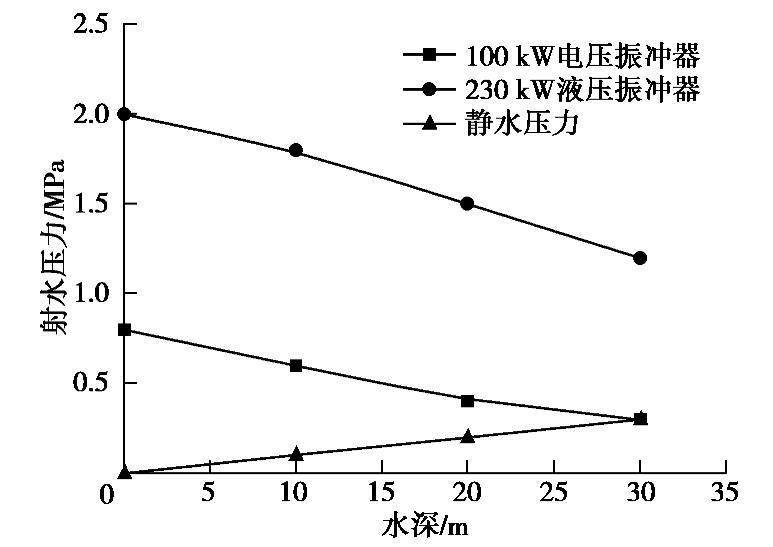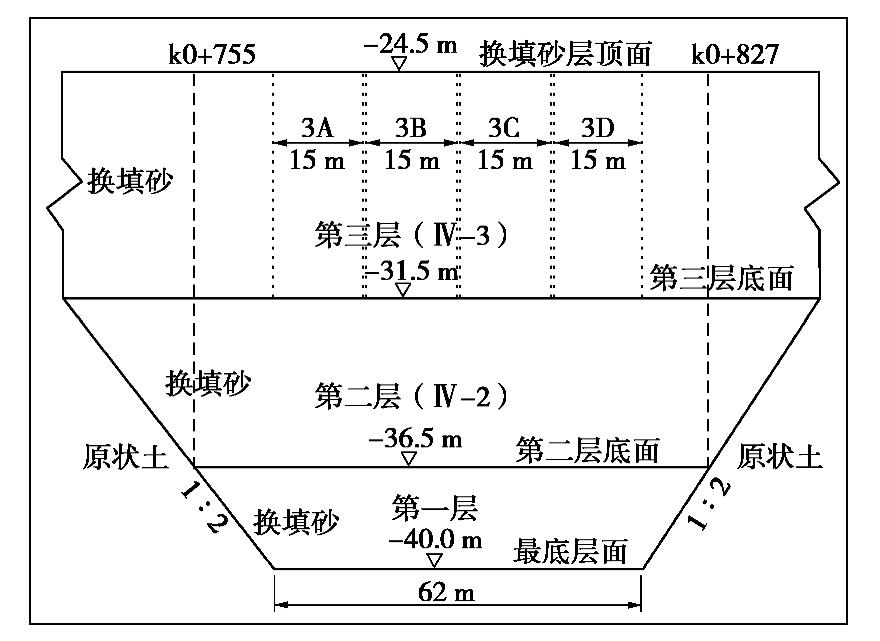Vibroflotation method for foundation treatment of replaced sandy soil in deepwater marine environment
-
摘要: 海洋环境特殊、场地条件较陆地更加复杂,水深超过20 m地基无料振冲加固尚无工程实践、技术标准、工艺参数借鉴与参考,现行有关振冲的规范与技术标准主要针对陆地地基,且基于早期、装备相对落后的工程经验认识。在科特迪瓦阿比让港口水深20~25 m条件下对原状地层进行基槽开挖、中粗砂换填,并采用100,180,230 kW的振冲器对换填砂层进行无填料振冲加固处理,分析常用振冲器在深水海洋环境下容易出现的问题,探讨深水海洋环境下换填砂土地基的单次加固深度、施工效率、加固效果、工艺参数等。结果表明:①海洋环境中振冲器容易出现脱焊或断裂、腐蚀而加速损坏、难以振冲至预定深度等问题,应慎重选择合适的振冲设备;②水深对振冲器加固深度影响十分显著,100,180,230 kW振冲器的单次加固深度分别为4~6 m,6~8 m,8~10 m,明显低于同等条件下陆地地基加固深度;③单个振冲孔的水平加固面积作为施工效率的评价标准,180 kW较100 kW振冲器的施工效率高56%,230 kW较100 kW的施工效率高125%;④深20~25 m、振冲器功率100~230 kW、处理厚度10~19 m、水平间距2~3.5 m、留振时间30 s等阿比让港口的振冲基本工艺参数,可为今后“一带一路”港口工程、岛礁吹填等海洋工程地基加固处理提供参考。Abstract: The marine environment is special, and its geotechnical site conditions are more complex than those on land. There have been no engineering practices, technical standards and technological parameters for reference in the foundation treatment of vibration-impact method with a water depth of more than 20 m. The current codes and technical standards of vibration-impact method are mainly applicable to land foundations, based on the engineering experience of early stage and relatively backward equipments. The excavation of foundation trench and the replacement of medium-coarse sand are carried out on the undisturbed soil layer under water depths of 20~25 m in Abidjan Port, and the vibration-impact machines of 100, 180 and 230 kW are used to treat the replaced sand layer. The issues of common vibrator problems in deepwater marine environment are analyzed, and the vibration-impact depth, construction efficiency, foundation treatment effect and technological parameters of vibration-impact method in deep-water marine environment are discussed. The results indicate that: (1) In the marine environment, the vibrator is easy to detach, or break, or corrode, and it is difficult to penetrate to a design depth, so the appropriate vibration-impact equipments should be carefully selected. (2) The depth of water has a significant influence on the foundation treatment depth of vibration-impact method. The foundation treatment depths of 100, 180 and 230 kW-vibrator is 4~6, 6~8 and 8~10 m, respectively, which are significantly lower than those of land foundation under the same conditions. (3) Taking the horizontal treatment area of foundation as the evaluation standard of construction efficiency, the construction efficiency of 180 kW-vibrator is 56% higher than that of 100 kW, and the construction efficiency of 230 kW-vibrator is 125% higher than that of 100 kW. (4) The parameters of vibration-impact method in Abidjan port, such as water depths of 20~25 m, vibrator powers of 100~230 kW, treatment thicknesses of 10~19 m, horizontal spacings of 2~3.5 m, vibration retention time of 30 s, can provide reference for the foundation treatment of marine geotechnical engineering in countries along "Belt and Road Initiative" in the future.
-
0. 引言
随着“一带一路”倡议的深入推进以及中国海洋环境的开发利用,越来越多的中国企业参与海内外的港口工程建设,深水海洋环境下软土地基评价与加固的工程需求与日俱增,因前期准备不足而造成重大损失的情形屡见不鲜。
水下软弱地基加固处理通常采用开挖换填块石、高压旋喷桩和水下深层水泥搅拌等,然而,这些方法造价较高、施工调度困难、工期较长[1]。振冲法是一种通过加水振动使砂土密实的一种地基加固方法,自20世纪70年代末引进中国已近40 a[2],被广泛应用于水运、交通与工民建等各领域的地基加固中[3]。现行有关振冲法的规范与技术标准主要针对陆地地基进行振冲处理,且基于早期、装备相对落后的工程经验认识,振冲器功率较低,一般30,55,75 kW[4],与当前振冲设备的装配水平与地基加固能力不相适应。当前,中国振冲设备的研发与应用已处于行业领先水平,工程界普遍使用30~130 kW的电压振冲器,130 kW以上的应用相对较少。另外,目前有少量水下振冲工程实践的文献报道,但其水深和处理厚度均较小[5-8]。然而,海洋环境特殊、场地条件较陆地更加复杂,超过20 m深水海洋环境下的地基进行振冲加固处理,目前尚无工程经验、技术标准、工艺参数借鉴与参考。
本文在科特迪瓦阿比让港口水深20~25 m条件下对原状地层进行基槽开挖、中粗砂换填,并采用100,180,230 kW的振冲器对换填砂层进行无填料振冲加固处理,探讨深水海洋环境下换填砂土地基的加固深度、施工效率、加固效果、工艺参数等工程上普遍关切的问题,分析常用振冲器在深水海洋环境下容易出现的问题,为振冲设备的选型、技术标准、工艺参数设计以及“一带一路”的岛礁海洋工程建设等提供依据。
1. 振冲法在海洋地基加固中的优势
海洋岩土工程受特殊海洋环境影响,大多常规陆地地基加固方法用于海洋岩土工程存在施工效率低、污染海洋环境、适用条件单一、加固效果差等问题,甚至难以应用,适宜海洋岩土地基加固的方法十分有限。同时,海洋工程需要考虑海水动力、侵蚀破坏、地震海啸等特殊作用因素,地基加固质量标准比陆地工程高,地基加固方法选择的标准与要求更高。由于经济发展迫切需要利用海洋土地资源,海洋岩土工程问题也成为国际前沿研究热点之一[9]。
根据土体扰动状态海洋岩土地基可分为:原状土地基与换填土地基,其中换填土地基根据搬运形式分为吹填土地基和堆填土地基。近岸海洋岩土工程往往采用堆填土造陆,当不具备堆填条件时则采用吹填土造陆,而远离近岸的远海工程,尤其是远海岛礁工程建设,只能采用吹填土造陆[10]。吹填土造陆所用材料的性质、加固标准决定了可选用的地基加固方法。无料振冲法特别适用砂土等非黏性土地基加固处理,海上施工较为方便、环境污染小,在海洋岩土工程地基加固中处于领先、重要的地位。
2. 试验区海洋环境与工程背景
试验区位于科特迪瓦阿比让港,该港口是西非地区最大的港口,码头结构包括:①新建现代化集装箱码头,共3个泊位,长度分别为375,375和500 m;②满足12000TEU集装箱船靠泊需要;③港池水深满足第五代集装箱船靠泊。
海面标高1 m,海水深度20~25 m。集装箱码头采用重力式沉箱,沉箱底部设计标高-18.5 m,沉箱以下为6 m厚的抛石地基。原状土层的地质条件十分复杂,深度、水平方向上淤泥、砂土软硬相间、混杂,呈现明显的不均匀性。原状土层从上至下主要分布淤泥、细—粗砂、黏土,局部土层为含腐木的有机质土。淤泥、黏土层标贯击数不足10击,不能满足承载力与变形的设计要求。为保证沉箱等上部结构的稳定,减少差异沉降,对原状土层进行基槽开挖,基槽的坡度为1∶2,基槽底部最大深度标高-40.0 m。开挖的基槽采用中粗砂进行换填,换填砂层的厚度为10~19 m,采用无料振冲法对换填砂层进行加固处理(见图1)。一般的码头地基加固后的标贯击数仅需达到15击/30 cm[11-12],而阿比让港口换填砂地基加固后标贯击数不低于22击/30 cm,属于高标准质量工程,这对深水条件下进行振冲加固处理提出了严峻的挑战。
无料振冲法对适用的土类有严格要求,需要控制换填砂的质量。一般认为无填料振冲法仅适用于细粒含量(粒径小于0.074 mm)不超过10%的中、粗砂地基[13-14]。Slocombe等认为,无填料振冲法可加固细粒含量(粒径小于0.06 mm)不超过15%或黏粒含量(粒径小于0.005 mm)不超过2%的砂性土[15]。Mitchell给出了振冲加固处理的级配范围,位于B区振冲加固效果最好,C区颗粒过细加固效果不佳[16],A区颗粒过粗振冲器难以贯入至设计深度。勘察结果表明,阿比让港口原状土层级配曲线接近C区边缘,不利于振冲处理,港口附近存在适宜振冲、储量丰富的中粗砂,细粒含量不大于5%,可作为基槽的换填砂,其级配曲线如图2。
试验采用100,180 kW电压振冲器以及230 kW液压振冲器。设备功率、频率、激振力、振幅等性能参数如表1所示。
表 1 试验所用振冲器性能参数Table 1. Parameters of vibrators型号 激振方式 功率/kW 频率/rpm 激振力/kN 振幅/mm 质量/kg 尺寸/mm 100A 电压 100 1480 190 17.2 1900 Φ402×3215 180A 电压 180 1480 320 18.9 3110 Φ402×4470 V230 液压 230 1800 388 24.0 3235 Ф420×5166 表1中型号V230液压振冲器的功率为230 kW,一般工程较少使用,对其做进一步的介绍。V230液压振冲器主要分为提取头、配管、抑制器、振冲头4部份(见图3),具体为:①提取头,通过吊臂分别连接振冲器和吊车;②配管,通过增减配管调整振冲长度,其中,1 m/节的标准配管与抑制器连接,5.5 m/节的配管(质量为1.9 t)用于延伸振冲器总长度并增加配重;③抑制器:抑制器含有橡胶减震块,将偏心块装置产生的振动与吊车隔离;④振冲头,由偏心块、液压马达、偏心块组成,液压系统由供油、回油和泄油组成。设备总长度约39 m,采用模块化集成,每一段配管为独立模块,可通过螺栓增加或者减少。头锥处及振冲器边上设喷水系统。
3. 深水海洋环境下振冲法容易出现的问题
3.1 振冲器的耐久性与稳定性
深水条件下施工电压振冲器减振胶的连接锁扣容易脱焊或断裂,振冲器容易短时间内被拔断而埋在土层中,需要经常维修甚至无法使用,这种情况在陆地地基加固极为少见。由于水深较大,振冲器悬吊长度较陆地条件下长20~40 m,激振时振冲器向四周摆动幅度更大,加上海洋水流作用,振冲器更容易发生水平偏移、重心不稳,振冲器需要更大的自身重量以增强在深水条件下的稳定性,但是,增加振冲器自身重量会降低振冲设备性能。陆地地基加固的振冲设备不一定适用于深水海洋环境条件。上述情况在既有成果中尚未揭示,工程建设中应引起足够的重视。
另外,海洋特有的长期高温、湿热环境具有较高的腐蚀性,振冲器长期处于海水中,加之长时间的磨损,导致设备容易损坏,局部一旦损坏后,海水会加剧腐蚀与损坏的速度。对于海上丝绸之路的海洋岩土工程,尤其在拉美地区等工程建设资源匮乏的国家,工程建设前应选择性能与耐久性适宜的装备。相对而言,230 kW液压振冲器采用模块化组装、不易损坏、耐久性较好。
3.2 单次振冲深度及其对工程的影响
本文阿比让港口海水深度20~25 m条件下中粗砂换填地基进行地基振冲加固处理,结果表明:
(1)深水条件下100 kW电压振冲单次加固深度仅4~6 m,超过6 m极容易出现振冲器被卡,单次加固深度宜为4 m。陆地中粗砂地基上100 kW振冲的加固深度10 m以上,表明水深对振冲器加固深度影响显著。阿比让港口换填地基加固厚度为10~19 m,采用100 kW电压振冲器需按4~5次分层换填、分层振冲,单次换填、振冲厚度4 m,工序复杂、成本高,难以满足项目工期要求。
(2)180 kW电压振冲器单次加固深度为6~8 m,加固深度较100 kW电压振冲器有所提升,单次加固深度宜为6 m。陆地中粗砂地基180 kW加固深度可达15 m,表明水深对该类型振冲加固深度仍产生严重不利影响。
(3)230 kW液压振冲器单次加固深度达到8~10 m,很少出现上拔困难等问题。因此,水深对振冲器加固深度影响十分显著,同等条件下较陆地地基加固深度低许多,这种情况在以往陆地工程以及研究成果中均未揭示。
对于某一特定岩土场地条件,激振设备选用主要考虑设备的功率,功率决定激振力、振幅等性能参数。周健等认为振冲器固有振动参数包括振动力、振动频率、振动加速度等对加固效果影响较大[17]。本文现场振冲试验进一步表明:激振器的功率、振幅、自重越大振冲加固深度越大,这一规律在深水海洋岩土地基中同样适用;激振力决定了振冲下穿土层深度;振幅和加速度决定了振冲加固面积。
4. 深水海洋环境下振冲工艺及其评价
4.1 不同振冲器施工效率对比分析
以单个振冲孔的水平加固面积作为施工效率的评价标准,单孔加固面积越大则施工效率越高。换填地基加固后标贯击数不低于22击/30 cm,振冲孔点位按等边三角形布置,振冲孔间距不同,其它工艺参数不变,比较100,180 kW电压与230 kW液压振冲的施工效率。3种振冲器的工艺参数与施工效率汇于表2。
表 2 3种振冲器工艺参数与施工效率Table 2. Parameters and construction efficiencies of three kinds of vibrators振冲器型号 水平间距/m 上提间距/m 留振时间/s 下沉速率/(m·min-1) 上提速率/(m·min-1) 单孔加固面积/m2 100A 2.0 0.5 30 5.0~7.0 5.0~7.5 3.2 180A 2.5 5.0 V230 3.0 7.2 由表2可知,100,180 kW电压与230 kW液压振冲器的单孔水平加固面积分别为3.2,5.0,7.2 m2。某一特定岩土条件下保持加固效果不变,施工效率与振冲功率呈线性增长关系,180 kW较100 kW电压振冲器的施工效率高56%,230 kW液压振冲较100 kW电压振冲器施工效率高125%。
4.2 不同振冲器加固效果对比分析
以平均标贯击数作为振冲后加固效果的评价指标,比较100 kW电压与230 kW液压振冲加固效果。虽然换填地基加固后的标贯击数不低于22击/30 cm,但不同功率振冲器下的平均标贯击数存在较大差别。加固地基出现标贯低值受土层均匀性影响较大,如果土层不均匀且土性较差,或某一很小范围未被加固,均可出现较低的标贯击数,因此最低值不能反映地基的总体效果,平均值更能反映不同振冲器地基加固后的整体效果。将同一深度换填砂地基加固后的平均标贯击数进行统计、分析,比较100,230 kW振冲器分别在孔间距2,3 m条件下的加固效果,见表3。
表 3 换填砂地基不同振冲器加固后标贯试验结果Table 3. Results of standard penetration tests after foundation treatment with different vibrators for replacement sand foundation加固范围 标高:-26~-32 m 标高:-33~-36 m 标高:-37~-40 m 参数 标高/m 平均标贯击数/(击·(30 cm)-1) 标高/m 平均标贯击数/(击·(30 cm)-1) 标高/m 平均标贯击数/(击·(30 cm)-1) 100A,孔间距2 m V230,孔间距3 m 100A,孔间距2 m V230,孔间距3 m 100A,孔间距2 m V230,孔间距3 m 加固效果 -26 45.8 49.9 -33 35.0 40.6 -37 27.3 29.3 -28 40.5 50.6 -34 41.8 47.2 -38 33.0 32.3 -30 43.3 53.6 -35 26.8 44.2 -39 27.7 35.1 -31 35.7 48.7 -36 44.3 44.6 -40 29.0 38.3 -32 53.2 72.0 — — — — — — 平均值 — 43.7 54.9 — 36.9 44.2 — 29.3 33.8 提升率/% — — 25.8 — — 19.5 — — 15.5 表3试验结果表明:
(1)在-26~-32 m、-33~-36 m、-37~-40 m深度范围内,100 kW振冲器加固后的标贯击数分别为43.7,36.9,29.3击/30 cm,230 kW振冲器加固后的标贯击数分别为54.9,44.2,33.8击/30 cm,随着海水与地基土深度的增大,振冲效果显著降低。
(2)对于标高-26~-40 m范围内的深水换填砂土地基,230 kW液压振冲器、3 m间距的地基综合加固效果较100 kW电压振冲器、2 m间距高15.5%~25.8%。
4.3 射水压力变化规律
振冲法通过高压水泵产生射水压力以抵抗周围土体的侧压力,提高造孔与穿透能力,射水压力越大、造孔与穿透能力越强。陆地振冲工程基本不考虑地下水深度的影响,近岸海洋工程水深不大,通常10 m左右[18],也基本不考虑水深对振冲施工效果的影响。但水深越大、静水压力越大,必然对施工效果产生影响。
本文试验100 kW电压振冲器,水泵功率为75 kW,扬程100 m,流量为45 m3/h,水泵常用出水压力为0.8 MPa。试验时在水下测试射水口压力值,发现随着水深的增加,射水压力会显著降低,水深20 m处射水压力很小;水深30 m处射水压力仅为0.3 MPa,射水压力损失或降幅达62.5%。水深30m处静水压力也达到0.3 MPa,此时振冲器的射水压力与静水压力基本相等(图4),受静水压力作用,振冲器射水对周围土体的作用力几乎为零,射水压力不足造成振冲器侧壁阻力增大,导致振冲器造孔能力大幅降低,容易出现振冲器被卡、被埋的情况,此时振冲贯入已进入失效状态。
230 kW液压振冲器水泵出水压力为2 MPa,为100 kW电压振冲器的2.5倍。30 m水深位置射水压力为1.2 MPa,压力损失率为40%,扣除静水压力作用,作用于周侧土体的水压仍达到0.8 MPa,说明该振冲器仍具备较强的造孔能力,贯入深度也更深。
4.4 振冲上提间距对加固效果的影响
为了进一步探索上提间距、振冲水平间距对加固效果的影响,选定230 kW液压振冲器进行对比研究。对比试验区位于集装箱码头Ⅳ区,水面标高1 m,水深25.5 m,基槽底部标高-40 m,换填中粗砂厚度为15.5 m。采用开底驳船换填中粗砂,换填分为3层,分层振冲,施工断面与分层情况如图5。在第三层(Ⅳ-3)土层根据振冲水平间距与上提间距不同,设置了4个独立分区,编号分别为3A、3B、3C、3D,每个分区的平面尺寸均为15 m×15 m,工艺参数见表4。
表 4 4个独立试验分区振冲参数Table 4. Vibroflotation parameters of four independent test zones分层 分区 水平间距/m 上提间距/m 留振时间/s 下沉速率/(m·min-1) 上提速率/(m·min-1) Ⅳ-3 3A 3.0 0.5 30 5.0~7.0 5.0~7.5 3B 3.0 1.0 3C 3.5 0.5 3D 3.5 1.0 在第三层(Ⅳ-3)土层开展对比试验,地基振冲加固前、后标贯击数试验结果见表5,表6为统计结果。
表 5 试验分区振冲加固前后标贯试验结果Table 5. Results of standard penetration tests before and after Vibroflotation foundation treatment标高/m 3A-前 3B-前 3C-前 3D-前 3A-后 3B-后 3C-后 3D-后 -24.5 7 8 6 8 22 23 23 24 -25.5 8 7 8 9 23 25 24 26 -26.5 8 6 8 12 24 27 25 28 -27.5 9 7 9 13 58 31 41 32 -28.5 12 8 11 14 56 38 50 40 -29.5 12 9 11 16 54 40 49 44 -30.5 13 11 12 16 55 41 52 43 注: “3A-前”表示3A分区振冲前的标贯击数(击/30 cm),“3A-后”表示3A分区振冲后的标贯击数,其他编号同理。表 6 试验分区加固前后标贯击数统计结果Table 6. Statistical results of standard penetration before and after foundation treatment分区 标贯平均值/(击·(30 cm)-1) 加固后与加固前比值 孔间距增大标贯降低幅度/% 上提间距增大标贯降低幅度/% 3A-前 9.9 — — — 3B-前 8.0 — — — 3C-前 9.3 — — — 3D-前 12.6 — — — 3A-前 41.7 4.2 — — 3B-后 32.1 4.0 — 22.9 3C-后 36.4 3.9 12.7 — 3D-后 29.7 2.4 7.6 18.4 由表6可知,试验区3A、3B、3C、3D加固后标贯击数平均值分别为加固前的4.2倍,4.0倍,3.9倍,2.4倍,表明总体加固效果显著。
对比不同上提间距对加固效果的影响。振冲孔水平间距均为3 m时,上提间距为1.0 m的3B区的标贯平均值较上提间距为0.5 m的3A区低22.9%。振冲孔水平间距均为3.5 m时,上提间距为1.0 m的3D区的标贯平均值较上提间距为0.5 m的3C区低18.4%。由此说明,增大上提间距振冲加固效果随之降低,保持振冲水平间距不变时,上提间距由0.5 m调整到1 m时,振冲加固效果下降约20%。
4.5 振冲孔水平间距对加固效果的影响
比较表6中3B与3C分区振冲后的标贯试验结果,两个试验区加固效果基本相当,表明通过调整振冲孔间距与上提间距的关系均能达到相同的地基加固效果。但是,增大振冲孔水平间距对施工效率的提升更为显著,建议优先选择调整振冲孔水平间距。
比较表6中3A与3C分区地基加固后的标贯击数,振冲孔水平间距由3 m增大至3.5 m,孔间距增大16.7%,加固效果下降12.7%,加固效果降幅低于孔间距增幅,孔间距的调整对加固效果影响相对较小。对比3B与3D分区加固后的标贯击数,孔间距增大16.7%,加固效果下降7.6%,加固效果降幅低于孔间距增幅,孔间距的调整对加固效果影响更小。
5. 水下振冲工艺参数对比
水下振冲特别是深水海洋环境下振冲的工程实践与经验较少,目前有少量水下振冲工程实例的文献报道,汇于表7。
结果显示,文献报道的水下振冲的水深3.1~14 m、处理厚度4~9 m、水平间距1.5~2.5 m、留振时间50~60 s,而本文阿比让港口水下振冲的水深20~25 m、处理厚度10~19 m、水平间距2~3.5 m、留振时间30 s,处理的水深更深、加固土层的厚度更大、施工效率更高,可为今后“一带一路”港口工程、岛礁吹填等海洋工程地基加固处理提供参考。
6. 结论
本文在科特迪瓦阿比让港口水深20~25 m条件下对原来地层进行基槽开挖、中粗砂换填,并采用100,180,230 kW的振冲器对换填砂层进行无填料振冲加固处理。分析了深水海洋环境下振冲法容易出现的问题,探讨了不同振冲工艺参数下的施工效率、加固效果等,取得了以下认识:
(1)海洋岩土地基加固中,无料振冲法具有施工较为方便、环境污染小等优势,但海洋环境中振冲器容易出现脱焊或断裂、腐蚀而加速损坏、难以振冲至设计深度等问题,应慎重选择合适的振冲设备。
(2)水深对振冲器加固深度影响十分显著,海水深度20~25 m条件下中粗砂换填地基,100,180,230 kW振冲器的单次加固深度分别为4~6 m,6~8 m,8~10 m,明显低于同等条件下陆地地基加固深度,以往研究成果未揭示。
(3)以单个振冲孔的水平加固面积作为施工效率的评价标准,180 kW较100 kW电压振冲器的施工效率高56%,230 kW液压振冲较100 kW电压振冲器施工效率高125%。
(4)-26~-32 m,-33~-36 m,-37~-40 m深度范围内,100 kW振冲器加固后的平均标贯击数分别为43.7,36.9,29.3击/30 cm,230 kW振冲器加固后的平均标贯击数分别为54.9,44.2,33.8击/30 cm,随着海水与地基土深度的增大,振冲效果显著降低。
(5)阿比让港口的振冲基本工艺参数:水深20~25 m,功率100~230 kW,处理厚度10~19 m,水平间距2~3.5 m,留振时间30 s,处理的水深更深、加固土层的厚度更大、施工效率更高,可为今后“一带一路”港口工程、岛礁吹填等海洋工程地基加固处理提供参考。
-
表 1 试验所用振冲器性能参数
Table 1 Parameters of vibrators
型号 激振方式 功率/kW 频率/rpm 激振力/kN 振幅/mm 质量/kg 尺寸/mm 100A 电压 100 1480 190 17.2 1900 Φ402×3215 180A 电压 180 1480 320 18.9 3110 Φ402×4470 V230 液压 230 1800 388 24.0 3235 Ф420×5166 表 2 3种振冲器工艺参数与施工效率
Table 2 Parameters and construction efficiencies of three kinds of vibrators
振冲器型号 水平间距/m 上提间距/m 留振时间/s 下沉速率/(m·min-1) 上提速率/(m·min-1) 单孔加固面积/m2 100A 2.0 0.5 30 5.0~7.0 5.0~7.5 3.2 180A 2.5 5.0 V230 3.0 7.2 表 3 换填砂地基不同振冲器加固后标贯试验结果
Table 3 Results of standard penetration tests after foundation treatment with different vibrators for replacement sand foundation
加固范围 标高:-26~-32 m 标高:-33~-36 m 标高:-37~-40 m 参数 标高/m 平均标贯击数/(击·(30 cm)-1) 标高/m 平均标贯击数/(击·(30 cm)-1) 标高/m 平均标贯击数/(击·(30 cm)-1) 100A,孔间距2 m V230,孔间距3 m 100A,孔间距2 m V230,孔间距3 m 100A,孔间距2 m V230,孔间距3 m 加固效果 -26 45.8 49.9 -33 35.0 40.6 -37 27.3 29.3 -28 40.5 50.6 -34 41.8 47.2 -38 33.0 32.3 -30 43.3 53.6 -35 26.8 44.2 -39 27.7 35.1 -31 35.7 48.7 -36 44.3 44.6 -40 29.0 38.3 -32 53.2 72.0 — — — — — — 平均值 — 43.7 54.9 — 36.9 44.2 — 29.3 33.8 提升率/% — — 25.8 — — 19.5 — — 15.5 表 4 4个独立试验分区振冲参数
Table 4 Vibroflotation parameters of four independent test zones
分层 分区 水平间距/m 上提间距/m 留振时间/s 下沉速率/(m·min-1) 上提速率/(m·min-1) Ⅳ-3 3A 3.0 0.5 30 5.0~7.0 5.0~7.5 3B 3.0 1.0 3C 3.5 0.5 3D 3.5 1.0 表 5 试验分区振冲加固前后标贯试验结果
Table 5 Results of standard penetration tests before and after Vibroflotation foundation treatment
标高/m 3A-前 3B-前 3C-前 3D-前 3A-后 3B-后 3C-后 3D-后 -24.5 7 8 6 8 22 23 23 24 -25.5 8 7 8 9 23 25 24 26 -26.5 8 6 8 12 24 27 25 28 -27.5 9 7 9 13 58 31 41 32 -28.5 12 8 11 14 56 38 50 40 -29.5 12 9 11 16 54 40 49 44 -30.5 13 11 12 16 55 41 52 43 注: “3A-前”表示3A分区振冲前的标贯击数(击/30 cm),“3A-后”表示3A分区振冲后的标贯击数,其他编号同理。表 6 试验分区加固前后标贯击数统计结果
Table 6 Statistical results of standard penetration before and after foundation treatment
分区 标贯平均值/(击·(30 cm)-1) 加固后与加固前比值 孔间距增大标贯降低幅度/% 上提间距增大标贯降低幅度/% 3A-前 9.9 — — — 3B-前 8.0 — — — 3C-前 9.3 — — — 3D-前 12.6 — — — 3A-前 41.7 4.2 — — 3B-后 32.1 4.0 — 22.9 3C-后 36.4 3.9 12.7 — 3D-后 29.7 2.4 7.6 18.4 -
[1] 王广生, 杨彦豪, 潘志刚. 重力式码头深水大厚度换填砂地基研究与实践[J]. 水运工程, 2019(7): 204-211. doi: 10.3969/j.issn.1002-4972.2019.07.036 WANG Guang-sheng, YANG Yan-hao, PAN Zhi-gang. Research and implementation of deep water and thick replaced sand foundation for gravity wharf[J]. Port & Waterway Engineering, 2019(7): 204-211. (in Chinese) doi: 10.3969/j.issn.1002-4972.2019.07.036
[2] 周健, 贾敏才, 池永. 无料振冲法加固粉细砂地基试验研究[J]. 岩石力学与工程学报, 2003, 22(8): 1350-1355. doi: 10.3321/j.issn:1000-6915.2003.08.023 ZHOU Jian, JIA Min-cai, CHI Yong. Vibroflotation compaction of silty fine sands without additional backfill materials[J]. Chinese Journal of Rock Mechanics and Engineering, 2003, 22(8): 1350-1355. (in Chinese) doi: 10.3321/j.issn:1000-6915.2003.08.023
[3] 楼晓明, 于志强, 徐士龙. 振冲法的现状综述[J]. 土木工程与管理学报, 2012, 29(3): 61-66. doi: 10.3969/j.issn.2095-0985.2012.03.013 LOU Xiao-ming, YU Zhi-qiang, XU Shi-long. Review on the present situation of vibroflotation improvement method[J]. Journal of Civil Engineering and Management, 2012, 29(3): 61-66. (in Chinese) doi: 10.3969/j.issn.2095-0985.2012.03.013
[4] 建筑地基处理技术规范:JGJ79—2012[S]. 2012. Technical code for ground treatment of buidings: JGJ79—2012[S]. 2012. (in Chinese)
[5] 冯强. 广州新沙工程大面积深水振冲加固[J]. 水运工程, 1992(3): 41-47. https://www.cnki.com.cn/Article/CJFDTOTAL-SYGC199203010.htm FENG Qiang. Large area and deep-water vibroflotation reinforcement of Xinsha project in Guangzhou[J]. Port & Waterway Engineering, 1992(3): 41-47. (in Chinese) https://www.cnki.com.cn/Article/CJFDTOTAL-SYGC199203010.htm
[6] 郑培成, 袁文明, 周荣官, 等. 厦门港东渡港区驳船码头基槽填砂的水下振密研究[C]//第三届全国地基处理学术讨论会论文集, 1992, 秦皇岛: 269-272. ZHENG Pei-cheng, YUAN Wen-ming, ZHOU Rong-guan, et al. Study on vibration density of underwater sand filling in foundation trench of barge Wharf in Dongdu port area of Xiamen Port[C]//The Third National Symposium on Foundation Treatment, 1992, Qinhuangdao: 269-272. (in Chinese)
[7] 冯强, 孔丽艳. 水下深层振冲法在港口工程中的应用[J]. 水运工程, 2000(7): 54-58. doi: 10.3969/j.issn.1002-4972.2000.07.014 FENG Qiang, KONG Li-yan. Application of underwater vibro-compaction method in port engineering[J]. Port & Waterway Engineering, 2000(7): 54-58. (in Chinese) doi: 10.3969/j.issn.1002-4972.2000.07.014
[8] 陈加庆. 厦门港某护岸工程砂基振冲密实处理[C]//第十二届中国海岸工程学术讨论会论文集, 2005, 昆明: 666-668. CHEN Jia-qing. Vibroflotation and compaction of sand foundation for a revetment project in Xiamen Port[C]//Proceedings of the 12th China Coastal Engineering Symposium, 2005, Kunming: 674-676. (in Chinese)
[9] 王立忠, 杨仲轩. 海洋岩土工程进展[J]. 国际学术动态, 2013(5): 21-23. WANG Li-zhong, YANG Zhong-xuan. Progress of marine geotechnical engineering[J]. International Academic Developments, 2013(5): 21-23. (in Chinese)
[10] 钱琨, 王新志, 陈剑文, 等. 南海岛礁吹填钙质砂渗透特性试验研究[J]. 岩土力学, 2017, 38(6): 1557-1564. https://www.cnki.com.cn/Article/CJFDTOTAL-YTLX201706003.htm QIAN Kun, WANG Xin-zhi, CHEN Jian-wen, et al. Experimental study on permeability of calcareous sand for islands in the South China Sea[J]. Rock and Soil Mechanics, 2017, 38(6): 1557-1564. (in Chinese) https://www.cnki.com.cn/Article/CJFDTOTAL-YTLX201706003.htm
[11] 黄锐. 换填砂及振冲密实工艺在码头工程中的应用[J]. 中国水运, 2012, 12(2): 213-214, 219. https://www.cnki.com.cn/Article/CJFDTOTAL-ZSUX201202101.htm HUANG Rui. Application of sand replacement and vibro-compaction technology in Wharf Engineering[J]. China Water Transport, 2012, 12(2): 213-214, 219. (in Chinese) https://www.cnki.com.cn/Article/CJFDTOTAL-ZSUX201202101.htm
[12] 张炜煌. 超深基础重力式码头结构选型与设计关键技术[J]. 水运工程, 2014(4): 52-56. https://www.cnki.com.cn/Article/CJFDTOTAL-SYGC201404014.htm ZHANG Wei-huang. Key technologies of structure selection and design for ultra -deep foundation trench gravity quay[J]. Port & Waterway Engineering, 2014(4): 52-56. (in Chinese) https://www.cnki.com.cn/Article/CJFDTOTAL-SYGC201404014.htm
[13] 叶书鳞. 地基处理工程实例应用手册[M]. 北京: 中国建筑工业出版社, 1998. YE Shu-lin. Application Manual of Foundation Treatment Engineering Example[M]. Beijing: China Architecture & Building Press, 1998. (in Chinese)
[14] MOSELEY M P, PRIEBE H J. Vibro Techniques, Ground Improvement[M]. Maryland: Blackie Academic and Professional, 1993: 1-19.
[15] SLOCOMBE B.C, BELLAL , BAEZHU . The densification of granular soils using vibro methods[J]. Géotechnique, 2000, 50(6): 715-72.
[16] MITCHELL J K. In-place treatment of foundation soils[J]. Journal of the Soil Mechanics and Foundations Division, ASCE, 1970, 96(SM1): 73-110.
[17] 周健, 王冠英, 贾敏才. 无填料振冲法的现状及最新技术进展[J]. 岩土力学, 2008, 29(1): 37-42. https://www.cnki.com.cn/Article/CJFDTOTAL-YTLX200801009.htm ZHOU Jian, WANG Guan-ying, JIA Min-cai. Situation and latest technical progress of vibroflotation without additional backfill reinforcement[J]. Rock and Soil Mechanics, 2008, 29(1): 37-42. (in Chinese) https://www.cnki.com.cn/Article/CJFDTOTAL-YTLX200801009.htm
[18] 韩冉冉, 徐满意, 乔小利. 水下超软土地基振冲碎石桩试验及参数控制[J]. 岩土工程学报, 2013, 35(增刊2): 612-616. https://www.cnki.com.cn/Article/CJFDTOTAL-YTGC2013S2109.htm HAN Ran-ran, XU Man-yi, QIAO Xiao-li. Vibro- replacement stone column tests and parameter controls of under water soft soil foundation[J]. Chinese Journal of Geotechnical Engineering, 2013, 35(S2): 612-616. (in Chinese) https://www.cnki.com.cn/Article/CJFDTOTAL-YTGC2013S2109.htm
-
期刊类型引用(8)
1. 杨光. 波浪补偿钻探设备在海洋岩土工程勘察中的应用. 价值工程. 2024(12): 111-113 .  百度学术
百度学术
2. 李石平. 水库坝基振冲处理试验研究. 珠江水运. 2024(13): 45-47 .  百度学术
百度学术
3. 宋大军,严军,卢一林,许奎鑫,徐小迟,高文斌,程昭. 振冲密实法在人工吹填砂土地基处理中的应用. 水运工程. 2024(10): 188-193 .  百度学术
百度学术
4. 占鑫杰,李文炜,杨守华,朱群峰,许小龙,黄慧兴. 振冲法加固堰塞体材料的室内模型试验研究. 水利水运工程学报. 2023(01): 72-82 .  百度学术
百度学术
5. 樊启祥,李果,马斌,陈涛,陈道想,林鹏. 深厚覆盖地基智能振冲方法与系统. 水利学报. 2023(12): 1393-1403 .  百度学术
百度学术
6. 胡利文,王德咏. 水下地基处理技术现状与展望. 宁夏工程技术. 2022(03): 193-201 .  百度学术
百度学术
7. 李春,谭维佳. 微生物诱导加固砂土的动力特性及微观试验研究. 人民长江. 2022(12): 173-178 .  百度学术
百度学术
8. 史天华,郭兴军,王志杰. 厄瓜多尔波索尔哈多用途码头项目地基底部出料振冲替代方案研究. 工程技术研究. 2021(19): 88-89 .  百度学术
百度学术
其他类型引用(6)



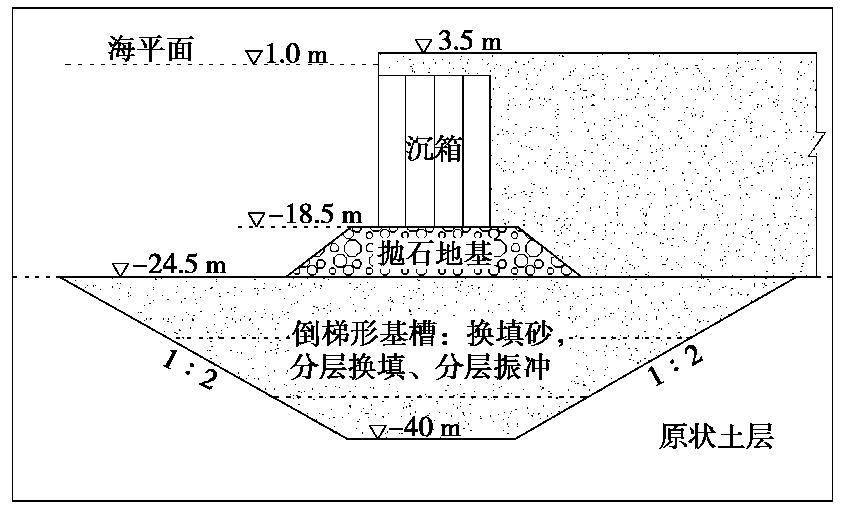
 下载:
下载:
